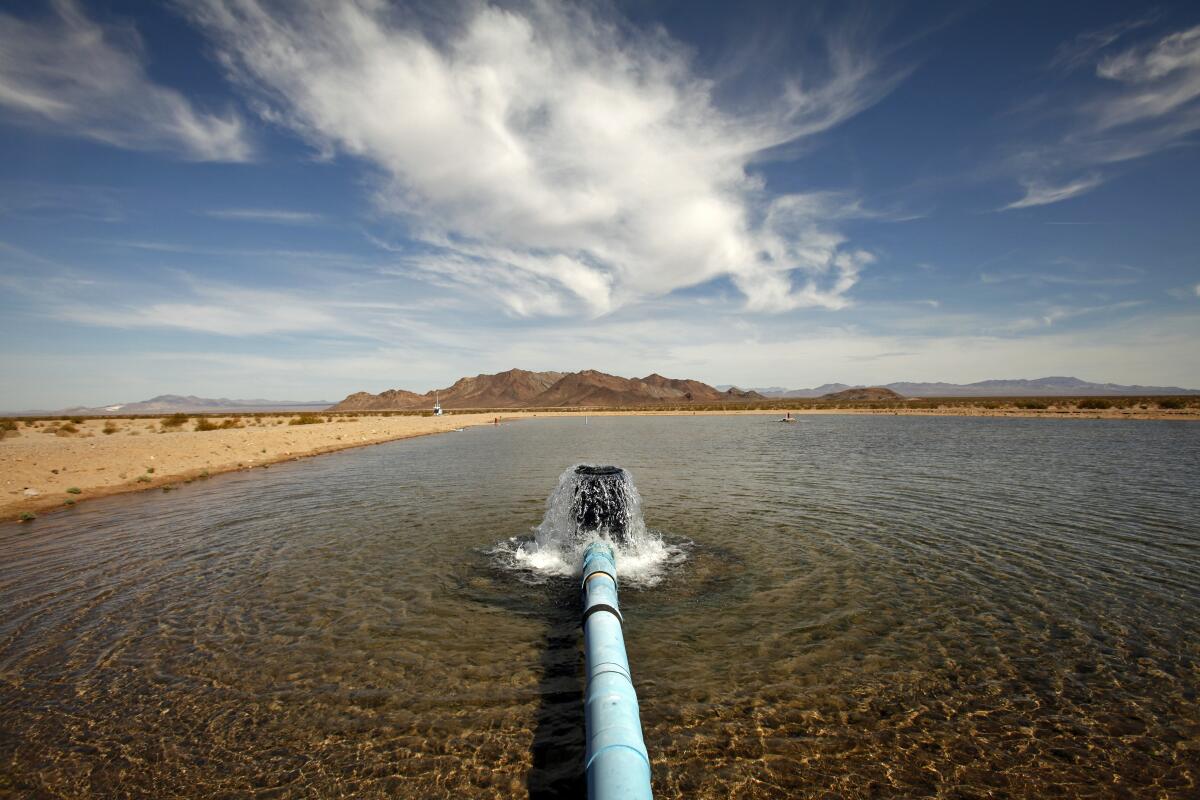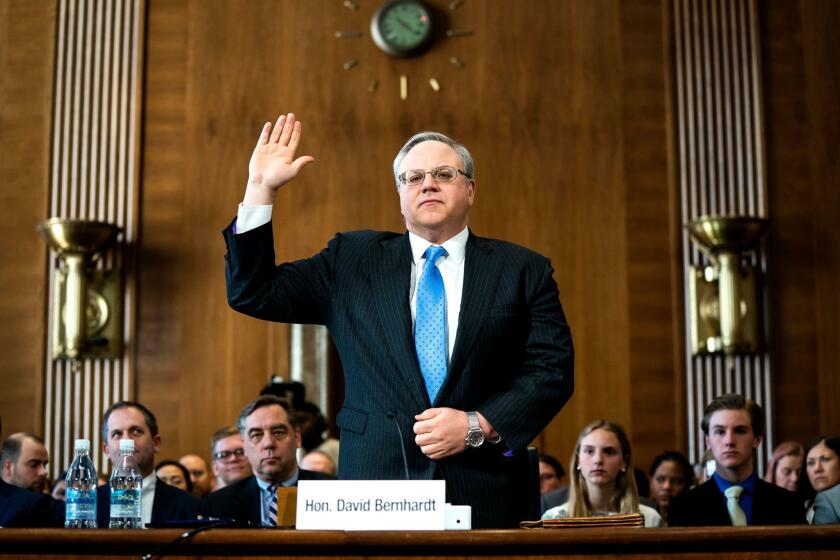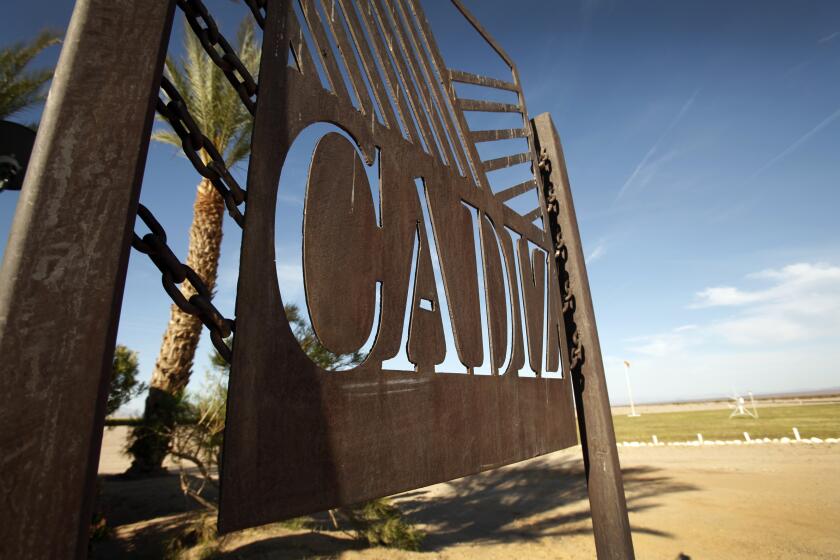Column: California’s most improbable water project rebrands itself as a crusader for environmental justice

- Share via
It’s hard to think of a California company that carries more toxic baggage than Cadiz Inc.
The Los Angeles firm has been trying for more than 20 years to advance a plan to siphon water from under the Mojave Desert and pump it to users throughout Southern California. It has long been stymied by environmental objections, but stayed on life support by wielding political influence and regular financings such as private stock placements and junk bond-rated debt.
Now Cadiz is trying a new tack. Under its newly installed chief executive, the veteran government aide Susan Kennedy, it has affiliated itself with the so-called human right to water movement, which ties the inaccessibility of clean water for disadvantaged communities to other social justice quests such as developing more affordable housing.
Kennedy has a long and distinguished record in government, including stints working for former Govs. Gray Davis and Arnold Schwarzenegger, and service on the state Public Utilities Commission and on the board that oversees Covered California, the state’s Affordable Care Act exchange.
I have a long way to go to change opinions.
— Cadiz CEO Susan Kennedy
Kennedy, who joined the Cadiz board in February 2021, became its chair a year later and took over as CEO on Jan. 1, freely acknowledges that this is a heavy lift for a company with Cadiz’s lengthy and discreditable history.
“In Sacramento, the Cadiz name is a poison pill,” she told me. Upon becoming CEO, she says, “the first thing I had to do was change the company so people think about it differently.”
Get the latest from Michael Hiltzik
Commentary on economics and more from a Pulitzer Prize winner.
You may occasionally receive promotional content from the Los Angeles Times.
That approach, Kennedy says, includes dumping the company’s long-term lobbying firm, which was closely connected with the Trump administration, and placing more community activists on its board.
Most important, in her view, is refashioning Cadiz’s water project from one aimed at serving urban users throughout Southern California to a narrower goal of filling the admittedly serious gaps in the accessibility of clean water in San Bernardino County.
“The problem before,” she says, was that the Cadiz project involved “taking water out of the Mojave Desert and shipping it halfway across California to fill swimming pools in Los Angeles.”
That left locals in the lnland Empire with little reason to favor the company’s proposal. “This is very different,” she says. “This is keeping water local — Mojave water staying in the Mojave basin. It’s a key solution for the area,” which has limited access to water from the Colorado River or the State Water Project, two of the principal sources of water in California.
Kennedy says Cadiz’s new focus will initially be on converting an old natural gas pipeline running 86 miles between its desert acreage and Barstow to carry its water. The recipients would be “severely disadvantaged communities” currently dependent on the state water project, supplies from which are heavily impacted by drought.
It has never been a great idea to count Cadiz entirely out of the race to sell its costly water deal to the public, considering its long history of lining up powerful political friends.
It’s an understatement to say that California environmentalists, who have fought the company tooth and nail for more than 20 years, are skeptical.
“Cadiz is conducting a rebranding effort because its project has been a massive failure for decades, it carries significant financial risk, and it stands zero chance of securing numerous required federal and state permits,” says Neal Desai, senior regional program director of the National Parks Conservation Assn.
To best understand this conflict, let’s start at the beginning.
The Cadiz desert water scheme was the brainchild of CEO Keith Brackpool, a British former stock trader with a checkered history — in 1983 he pleaded guilty to criminal charges including dealing in securities without a license, and several years later was forced out of an executive role with a British food company for some dealings with a direct competitor.
Cadiz owned 35,000 acres overlying a desert aquifer. Cadiz‘s proposal to the giant Metropolitan Water District in 1997 “had a charming 25-words-or-less simplicity,” I wrote in 2006: The MWD would store its surplus water beneath Cadiz’s acreage in wet years and retrieve it during droughts, paying Cadiz a fee at both ends.”
Difficulties soon surfaced. The storage site was 35 miles from the MWD’s Colorado aqueduct, requiring a $150-million pipeline to be strung over environmentally sensitive territory.
The proposal committed the district to buy huge quantities of groundwater from Cadiz’s aquifer, but experts disagreed about how much could be safely extracted from the site; Cadiz estimated 30,000 acre-feet a year, but the U.S. Geological Survey and other independent sources regarded the estimate as optimistic by at least a factor of 10. The persistent drought in the West raised doubts over whether there would ever be much surplus for the MWD to store.
Then there were the company’s finances. One doesn’t wish to be churlish, but if you decide to open its most recent financial statement covering the first nine months of 2023, I’d advise doing so in a well-ventilated space.
The company reported an operating loss of $24.7 million on revenue of $1.3 million for that period, compared with a loss of $17.9 million on sales of $927,000 a year earlier. All the revenue comes from a farming operation on its desert landholdings. Cadiz hasn’t reported a profit since its first public financial disclosure in 1994; its accumulated deficit reached $603.3 million in 2022.
It was obvious even during the presidential campaign that Donald Trump didn’t know much about water policy and didn’t have much inclination to learn.
The original plan called for the $150-million cost to be shared by Cadiz and the MWD. Since Cadiz didn’t have the proverbial pot to, er, fill, it proposed that the MWD lend it the money for its share, largely through a “prepayment” for the storage of MWD water. But the company’s existing lenders had the right to demand repayment of their loans from any funds provided by MWD, so almost nothing would be available for construction.
The MWD rejected the plan in 2002. By any rational expectation, that should have killed the project for good.
But its critics didn’t reckon with Brackpool’s ability to endow his firm with political supporters.
Although the late Sen. Dianne Feinstein (D-Calif.) was a sworn adversary, her opposition was counterbalanced at first by advocates such as former Gov. Gray Davis, whose 1998 and 2002 gubernatorial campaigns collected $235,000 in donations from Cadiz.
In return, Davis made Brackpool his advisor on water. Their relationship put pressure on the MWD to play ball with Cadiz, which may have explained why it took the water district until 2002 to put the kibosh on the plan.
Over subsequent years, Brackpool hobnobbed with former Los Angeles Mayor Antonio Villaraigosa, who landed for a time on the company’s payroll. In 2006, he persuaded then-Gov. Arnold Schwarzenegger to endorse Cadiz as “a path-breaking, new, sustainable groundwater conservation and storage project.”
The most important support may have come from Donald Trump. He appointed David Bernhardt, a former lawyer and lobbyist for Cadiz, as his Interior secretary in 2019, giving Bernhardt authority over crucial federal approvals the company needed for its desert pipeline.
Bernhardt came from the law firm Brownstein Hyatt Farber Schreck, which included Cadiz as a client; the company’s then-CEO, Scott Slater, was — and is — a partner in the firm. Cadiz had paid the Brownstein firm $2.75 million in lobbying fees and 200,000 shares of stock while Bernhardt was there. Bernhardt is now back at the firm, serving as a senior counsel in its Washington office. Slater, who no longer has an executive or governance role at Cadiz, is currently listed as a member of the law firm’s executive committee.
Westlands Water District is about to get a rich deal from Interior Secretary David Bernhardt, its former lawyer.
In December 2020, as the Trump administration was preparing to leave office, the Bureau of Land Management, an Interior Department subagency, abruptly approved Cadiz’s acquisition of the gas pipeline crossing the Mojave and for its conversion to carry water — ruling that the acquisition and conversion required no environmental impact studies. That was a “rushed, cursory decision,” a federal judge later found.
The Biden administration rescinded the approvals in 2021 so the BLM would have time to perform the environmental analysis required by law. Last month the agency reissued the approval for Cadiz to acquire the gas pipeline, but not to convert it for water. The latter decision, it had earlier assured Feinstein, would require “intensive environmental studies of ... potential impacts,” including those caused by the extraction of water from the aquifer.
Kennedy says Cadiz no longer employs Brownstein and recognizes that the 2020 BLM ruling was vulnerable to legal challenge. Brackpool retired from the Cadiz board last year, which apparently ended his relationship with the company.
That points to perhaps the most serious obstacle to Cadiz’s project: Doubts about the environmental impact of taking water from the Mojave aquifer. Kennedy says the company has in hand technical studies indicating that it can safely extract 50,000 acre-feet of water annually for 50 years without causing environmental damage. But those studies are at odds with decades of independent and government studies placing the safe extraction level in the neighborhood of about 30,000 acre-feet and as low as 3,000. Settling this crucial technical issue could take years.
And that brings us to a linchpin of Kennedy’s efforts to change Cadiz’s image from water profiteer to responsible steward of a precious, and increasingly scarce, natural resource. She points out, accurately, that as many as 1 million Californians lack reliable access to clean water.
The Cadiz water scheme has been a dead-project-walking for two decades. Biden may finally put it in the grave.
The question is whether Cadiz is the answer to the problem. Kennedy says it is, for inland water users. If environmental groups would only sit down with her “and map out an optimal water strategy, we would be part of that — what we’re doing would be key for that area of the state.”
Yet established organizations that have been focused on environmental justice say they haven’t heard from Cadiz. The company has associated itself with a new group called Groundswell for Water, which appears to be a coalition of community groups, few of which have played any prior role in water policy, but which received startup funding from Cadiz.
Among the established groups that say they haven’t received outreach from Cadiz are the Environmental Justice Coalition for Water and Clean Water Action. The Sierra Club and the Center for Biological Diversity were plaintiffs in a federal lawsuit that challenged a Trump-era decision allowing the water project to move ahead.
Through its spokesman Ed Sanders, Groundswell says it doesn’t represent Cadiz but aims to represent “the one million Californians, primarily people of color, who don’t have access to clean water. “
The group’s major misstep may have been to imply an association with Dolores Huerta, who was a top associate of Cesar Chavez in the United Farm Workers movement and remains, at 93, an icon of progressive community activism.
Having discovered that it was posting photographs of her and using her name as though she was a member, an infuriated Huerta issued a public letter crisply condemning Groundswell as “an astroturf group ... co-opting the language of environmental justice” and seeking “to pit organizations of color against environmental groups.”
Can Cadiz succeed in its new guise? In her favor, Kennedy can cite the undeniably intensifying water crisis, not merely in the Inland Empire but statewide. This will dial up the pressure to exploit new water sources of all varieties.
Cadiz’s ambitions have distinctly shrunk since it first sprang from Brackpool’s imagination. Kennedy says that the firm’s plan today is to turn a profit entirely from the sale of water to Inland Empire water districts. They, not Cadiz, would be the applicants for state and federal permits, which she hopes might make it harder for regulatory agencies to ignore their interests.
On the other side is a very suspect corporate history. That’s the hill Kennedy still must climb. She says outreach to environmental and community groups is high on her agenda, but their resistance to anything labeled “Cadiz” is potent indeed. “I have a long way to go to change opinions,” she says.
More to Read
Get the latest from Michael Hiltzik
Commentary on economics and more from a Pulitzer Prize winner.
You may occasionally receive promotional content from the Los Angeles Times.














